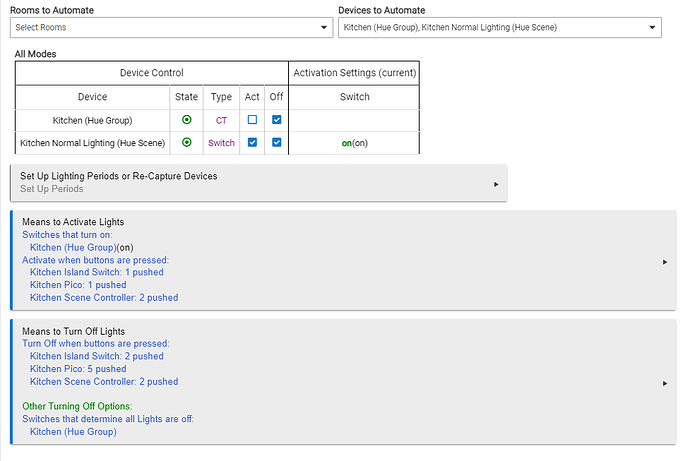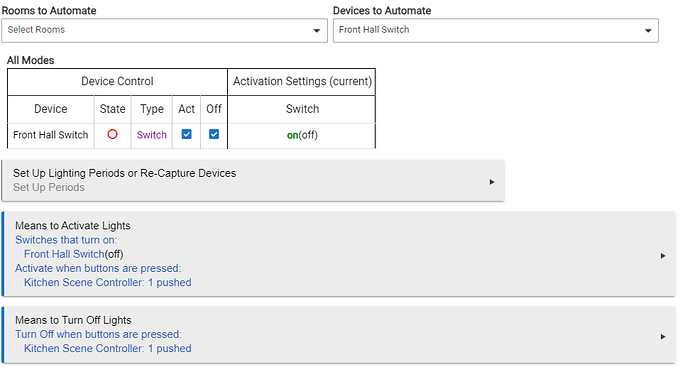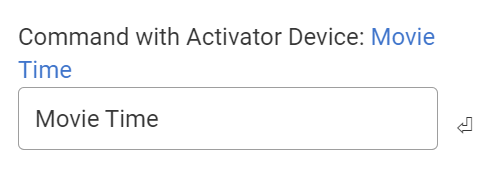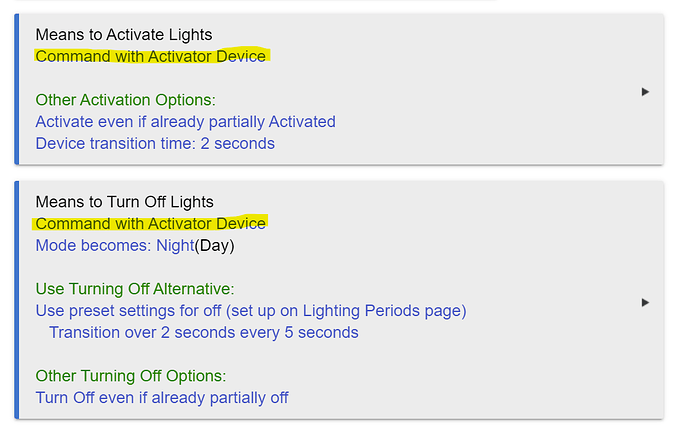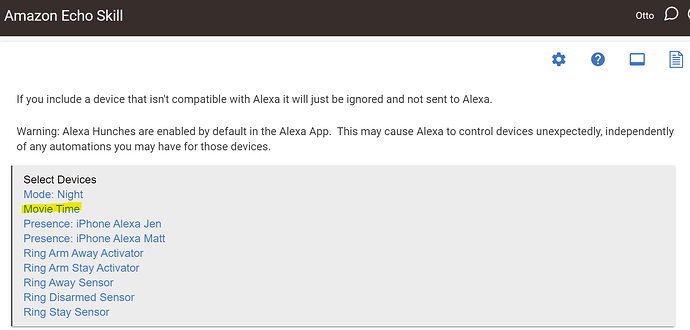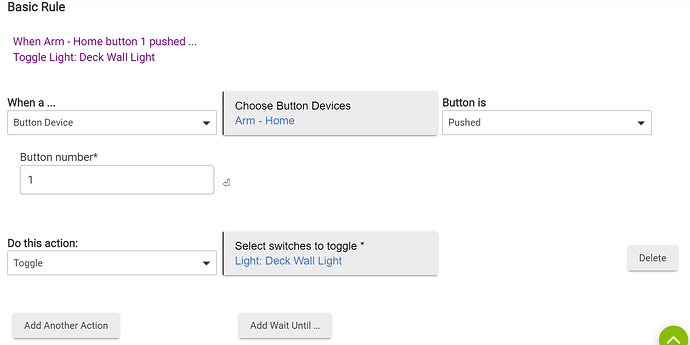I didn't even know about this app until a week ago.
I have Zooz switches, Hue bulbs, and a few Lutron Picos. These three things work very well together.
Now that I have my head around it, it worked great for a few more rooms where I added smart switches and bulbs. Here are some things I wish I had known from the beginning:
-
If you don't already have Rooms set up in Hubitat, you don't need to set them up. In fact even if you do use Rooms for other things, I suggest not using them in Room Lighting. This was tripping me up because what it was suggesting as defaults for the RL rule was not even close to what I needed. Better to build the rule from scratch by directly selecting the devices.
-
Don't think of it as turning on and off lights. Think of it as activating and deactivating the Room Lighting rule itself. Think of the RL rule as a just another device, and it activates/deactivates based on events you configure (the "means to" sections). When the rule is activated/deactivated, the things defined in the Device Control table happen. You don't necessarily have to turn on or off every device in the table, that's what the Act and Off checkboxes are for. If Act is checked for a device, it is turned on when the RL rule is activated. Vice versa for the Off checkbox.
-
You can think of a button event (ie button 2 pressed) as a toggle. You put it in both the means to activate, and the means to turn off. When you press the button, if the RL rule is active it'll deactivate. If it's not active, it'll activate. No more if/thens!
-
The devices in the "means to" sections do not have to be in the Device Control table. This was throwing me off. I used Zooz switches in smart bulb mode (meaning leave the relay on at all times) but I had the switches in the Device Control table so the rule activating/deactivating was issuing a "turn on/off" command to the switch. Taking the switches out of the Device Control table solved that.
-
You can define more than one "means to" method. Typical ones are "switch turns on" and "button pressed." For me I use button press, because my switches are in smart bulb mode. But I do have one switch that controls dumb bulbs so I don't use smart bulb mode. I realized I do have to have the switch in the Device Control table because the switch is the thing being turned on and off.
-
If you have external things that bypass Hubitat and directly control the lights - like Alexa voice commands - then you want to include the bulb(s) turning on and off as one of the things that activates/deactivates the RL rule. Say you press the wall switch, activating the RL rule, and the lights are on...then you use Alexa to turn the lights (smart bulbs) off directly...the RL rule is still activated. So when you try to use the switch to turn the lights on, it doesn't do anything. You have to press off on the switch to deactivate the RL rule, then on again to activate it. By using the bulbs (in my case a Hue group) as one of the things that activates/deactivates the RL rule, when Alexa turns the Hue group on and off, it activates/deactivates the RL rule.
Here is a good example of a typical room: pendants with Hue smart bulbs hanging over the kitchen island, a Hue light strip under the cabinets. I have 3 switches: Zooz on/off at one end of the kitchen, a Zooz scene controller at the other end, and a Pico on the wall above the countertop.
My goal:
- Zooz switch - turn kitchen lights on (Hue scene) and off
- Zooz scene controller - a button press toggles the lights on (Hue scene) and off
- Pico remote - turn kitchen lights on (Hue scene) and off
This is the RL rule:
The devices to automate are a Hue group and a Hue scene. The scene does control the same Hue group but within Hue. I don't do any individual light control in Hubitat.
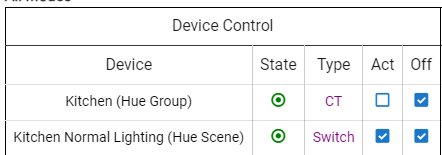
Even though the group and scene are the same bulbs, I have both in here. This is because I want the rule to use the scene to turn on the lights, but I also want the on/off status of the Hue group updated for external reasons.
The "means to activate" has the Hue group in it so that Alexa commands that bypass Hubitat still activate/deactivate the RL rule. The others are straightforward, a specific button on each switch.
The "means to turn off" (ie deactivate the RL rule) is set the same, but the configuration steps are different - you have to go into "Turn Off Light Options" at the bottom:
Again, that is so when Alexa turns the lights off, it deactivates the RL rule.
This is a rule I did for a Zooz switch controlling a dumb bulb, so I did not put the switch in smart bulb mode. It's just a "turn the switch on/off" rule. Notice that I mapped one of the scene controller buttons as a toggle. This works awesome and is so much simpler than Button Controller, Rule Machine, etc.
Notice that I have the same scene controller button (1 pushed) in both means to activate and means to turn off. This is what I meant when I said it works as a toggle. Press button 1 and if the rule is active it deactivates, if it's not active it activates. No more messing with if/then statements!
So these are the rules I have so far.
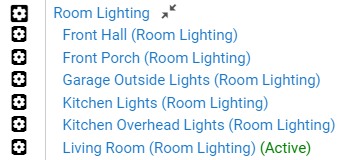
That all controls 7 Hue smart bulbs and 2 Hue LED strips spread across four rooms (outside front, front hallway, kitchen, living room), plus a dumb bulb chandelier and dumb bulb ceiling lights, using 4 Zooz switches, 2 Zooz scene controllers, and 2 Picos.
80% of that I installed in the last 2 weeks. If I hadn't bumped into the Room Lighting app last week, I would have done it all in Button Controller and it would have been far more complicated.
